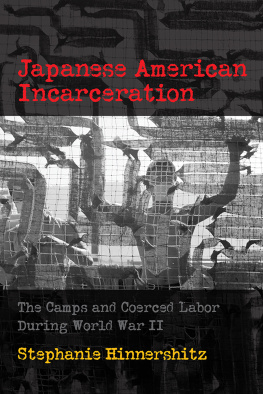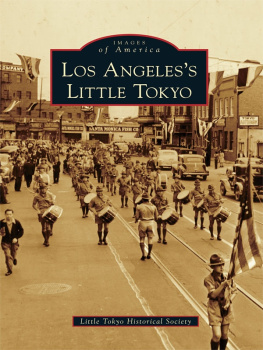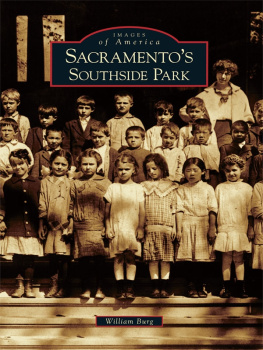

Published by The History Press
Charleston, SC 29403
www.historypress.net
Copyright 2013 by Kevin Wildie
All rights reserved
First published 2013
e-book edition 2013
Manufactured in the United States
ISBN 978.1.62584.644.0
Library of Congress Cataloging-in-Publication Data
Wildie, Kevin.
Sacramentos historic Japantown : legacy of a lost neighborhood / Kevin Wildie.
pages cm
Includes bibliographical references and index.
print edition ISBN 978-1-62619-186-0 (paperback)
1. Japantown (Sacramento, Calif.)--History. 2. Japantown (Sacramento, Calif.)--History--Pictorial works. 3. Japantown (Sacramento, Calif.)--Biography. 4. Japanese Americans--California--Sacramento--Interviews. 5. Oral history--California--Sacramento. 6. Japanese Americans--California--Sacramento--History. 7. Sacramento (Calif.)--History. 8. Sacramento (Calif.)--History--Pictorial works. 9. Sacramento (Calif.)--Biography. I. Title.
F869.S12W55 2013
979.454004956--dc23
2013032988
Notice: The information in this book is true and complete to the best of our knowledge. It is offered without guarantee on the part of the author or The History Press. The author and The History Press disclaim all liability in connection with the use of this book.
All rights reserved. No part of this book may be reproduced or transmitted in any form whatsoever without prior written permission from the publisher except in the case of brief quotations embodied in critical articles and reviews.
In Memory of Wayne Maeda
(19472013)
CONTENTS
FOREWORD
No longer does the Tripper or Tokyo Express travel down Fourth Street to pick up the students going to school; no longer do people walk down Japanese Alley greeting neighbors near homes located behind the stores or finding children playing kick-the-can; no longer is Kabuki performed or Japanese movies with live narration screened at the Nippon theater or the Boxing Hall. No physical reminders are left of Sacramentos Japantown that was not once, but twice abruptly disruptedfirst by the mass removal and incarceration of Japanese Americans during World War II and then by the complete obliteration of the streetscape in the name of redevelopment in the late 1950s. Only through hearing the memories of those who lived and worked in the area surrounding Fourth Street does the vigor of the neighborhood come back to life. Through family photographs, archival documents and a lively narration from Nisei interviews, Kevin Wildies Sacramentos Historic Japantown: Legacy of a Lost Neighborhood creates a moving picture of what once was.
Having visited remnants of former Japantowns throughout the state and having met community members who shared their memories with the Preserving Californias Japantowns project, we relish the stories from Nisei that infuse us with understanding of the resiliency and strength that helped them endure, rebuild and sustain community. For agricultural workers in the Delta and Northern California region in the 1930s and 40s, Sacramentos Japantown was the anchor. For the Japantown residents who returned after the war, it was their hometown. Sacramento native Fred Matsuda reflected, There was something rich about the way we all lived. You cant get that now.
Sacramentos Japantown is erased but not forgotten.
Jill Shiraki and Donna Graves,
Preserving Californias Japantowns
ACKNOWLEDGEMENTS
My first thanks go to Cheryl Anne Stapp, author of Sacramento Chronicles: A Golden Past, for helpful advice and connecting me to Aubrie Koenig, commissioning editor at The History Press. Without Aubries invaluable insights, creative vision, patient guidance and wise suggestions, this book would never have been published.
This book was formed over two phases: 19941998 and the summer of 2013. Over this long stretch of time, I have become indebted to a number of people. First, my deep appreciation goes to Dr. Joseph Pitti and Wayne Maeda, my two graduate advisors at California State UniversitySacramento, who provided guidance in the early formation of this book. I would never have been able to write this book if it were not for Toko Fujii, Kanji Nishijima, Fred Ouye, Alice Hayashi, Frank Hiyama, James Kubo, Jerry Miyamoto, Dean Itano, Karri Yagi, Eugene Okada, Sooky Lee, Kan Sanui, Jerome Lipp, Michiko Takahashi, Fred Matsuda, Amy Wong and April Adachi. Their willingness to share their experiences greatly enriched my life and made this project all the more rewarding.
I would like to thank all those who were willing to share memories and photos, identify people and places and connect me with others, including Sybil Miyamoto, Hideko Oya, Yomisu Oya, Marielle Tsukamoto, JoAnn Fujikawa, Fred and Katie Shirasago, the Shimono family, Melvin Okamoto, Mike Sawamura, Carolyn Ishii, Cindy Kitade, Joseph Fukuda, Victor Shibata, Gene Itogawa, Terry Kornelly, Barbara Zweig, Douglas Kubo, Lloyd Ouye, David Taketa, George Hisatomi, Jane Komure, Bonnie Okamoto, Donna Komure-Toyama, Keiko Komura and Ben Pease of Pease Press Maps.
My deep appreciation goes to Jill Shiraki and Donna Graves of Preserving Californias Japantowns for proofreading the manuscript and writing the foreword. Marian Uchida, Christine Umeda and Donna Komure-Toyama played a memorable and cherished role in this project. They reviewed the manuscript, offered valuable suggestions on layout and accurate terminology for the World War II experience, hunted down photos, identified individuals and shared their experiences. I also want to thank my father-in-law, Yoshimitsu Yajima, for translating Japanese and Chinese characters on documents and images.
I extend thanks to the helpful staff and individuals from many institutions, including those at the Sacramento Room, Sacramento Central Library; the Center for Sacramento History; the California History Room, California State Library; Susan Snyder at the Bancroft Library, University of CaliforniaBerkeley; and Julie Thomas at Special Collections and University Archives, California State UniversitySacramento.
Lastly, I want to thank my mom and dad, Nordell and Terri Wildie; my wife, Vanessa; and my two girls, Maddie and Allie. Their patience and accommodations throughout the formation of this project carried me to the end.
INTRODUCTION
On June 15, 1954, Henry Taketa, a prominent Japanese American attorney in Sacramento, California, appeared before the Sacramento City Council with more than one hundred Japanese American supporters. They were concerned about a proposed redevelopment project in downtown Sacramento that threatened the very existence of their neighborhood. Taketa opened his remarks with a sentimental appeal:
We have our whole heart and soul in what will take place here. Our fathers and mothers came here in their youth, and now they are reaching the twilight years of their lives. But in the meantime, they have worked hard, industriously, and provided a foundation for us, for the young generation. We have a considerable fondness for our community. For that reason, after our wartime dislocation, we always dreamt of coming back here. I would say 90 percent of us have returned.
The community of which Henry Taketa spoke so fondly dated back to the late nineteenth century, a time when Sacramento stood as one of the most important distribution points for Japanese laborers throughout the California Delta region. By 1910, Sacramento had become the fourth most Japanese-populated city in the state. During slow periods of the agricultural season, many Issei (first-generation) field laborers gathered in downtown Sacramento, in a six-block section bound by L and O and Third and Fifth Streets. A Japanese population settled in this neighborhood, while enterprising Issei families established more than two hundred businesses to serve the needs of this growing population. Colorful lanterns and flying windmills decorated Japanese Town Alley, a strip in the heart of Japantown well known for its sumo tournaments. In the olden days in the evening, recalls Chikaji Teramoto, twelve or one oclock, you could walk down Japanese Town Alley and hear the shamisen and some ladies and men singing. And that was natural every night. Ai Miyasaki was surprised when she arrived in Sacramento in 1918: It was like JapanThe groceries, like in Japan, were displayed outside the storeThere was even a Japanese bathhouse and a few Japanese doctors.
Next page









